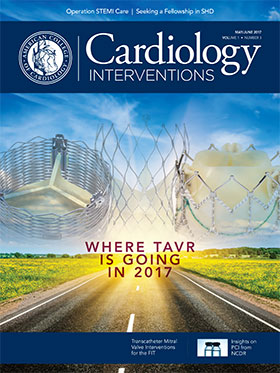New Research from NCDR: Provides Insights For Improving Patient Quality
In the past month, a handful of new studies using data from one of NCDR’s 10 registries have been published in the Journal of the American College of Cardiology and its sister journals, including JACC: Interventions. By monitoring more than 25 million patient records, these registries provide researchers with the ability to compare real-world outcomes with trial results, identify trends consistent with other studies worldwide and bring forward-looking insights to working towards improving cardiovascular care. Here we highlight two of these recent studies to help the busy physician incorporate some of these findings into their practice.
Bivalirudin or Heparin for Transradial Primary PCI?
Results from a study led by Ion S. Jovin, MD, FACC, et al., found no significant difference in the rate of the composite of death, myocardial infarction or stroke in patients undergoing transradial primary PCI for STEMI, whether anticoagulated with bivalirudin or heparin.
The study authors looked at 67,368 patients with STEMI who underwent transradial primary PCI between 2009 and 2015 in ACC’s CathPCI Registry. Of the total patient sample group, 29,660 received bivalirudin and 37,708 received heparin.
In the unadjusted comparison, while there was no significant difference between the two groups for the rate of the composite endpoint, there was a significantly higher rate of acute stent thrombosis with bivalirudin compared with heparin.
Similar findings were seen after adjustment for multiple variables and determining the propensity score. The risk of a composite endpoint was similar with bivalirudin and heparin (odds ratio, 0.95), and the risk of an acute stent thrombosis was more than two-fold higher with bivalirudin than with heparin (odds ratio, 2.11). Major bleeding rates were not significantly different between the groups.
While the data echo similar contemporary studies, there were differences in the results in relation to the approach used for PCI. Thus, the authors suggest the need for a randomized trial that compares patients treated exclusively with transradial primary PCI and who are anticoagulated with bivalirudin or heparin. They also state a cost-effectiveness analysis may benefit practitioners and hospitals to guide decision-making for anticoagulation therapy.
“If we really want to know whether bivalirudin is needed in radial-based primary PCI, we need to repeat [the HEAT-PPCI trial],” says Harold L. Dauerman, MD, FACC. In an editorial comment, he explains that “given the growth of radial primary PCI in the United States, a trans-Atlantic trial of radial access primary PCI is possible...”
“Until this trial is run, the large national registries will show us how our nations compare but tell us little about who is actually right,” he adds.
Predictive Models May Assist Patient Selection for Greater Benefit From ICDs
The Seattle Heart Failure Model (SHFM) and Seattle Proportional Risk Model (SPRM) may help physicians determine which patients would benefit from an ICD, according to a study led by Kenneth C. Bilchick, MD, FACC, and colleagues.
The investigators evaluated outcomes in 98,846 patients with heart failure. Of these, 87,914 patients had an ICD and were enrolled in the NCDR’s ICD Registry. The risk of death over a five-year follow-up period was 25 percent lower in the patients who had an ICD implanted compared with those who did not. Notably, their analysis found that by combining the SHFM and SPRM models it was possible to predict the survival benefit for a patient from having an ICD implanted.
By identifying subgroups, the researchers found that 25 percent of patients with ICDs had a 40 percent reduction in mortality during the follow-up period. Another 25 percent of ICD patients did not receive significant survival benefits; these patients were likely to have a 5.7 percent or less predicted annual risk of death and predicted proportion risk of sudden death of 50 percent or less. The remaining patients fell somewhere in between in regard to survival benefits.
The authors conclude that “the SHFM provided a highly effective measure of HF outcomes, whereas the SPRM provided a powerful measure of the proportional risk of sudden death.”
“Considering the large amount of time and expense presently allocated to patients with ICDs for implantation, post-operative care, and subsequent generator changes, application of these models could more effectively allocate the health care resources and personalize device therapy for the benefit of patients and society,” they explain. They recommend a study to analyze the patients who were characterized as low risk by the SHFM and SPRM models.
Scott D. Solomon, MD, FACC, and Neal A. Chatterjee, MD, comment that the investigators “have offered us an important step forward in sudden death prevention.” They state in an editorial comment that “our contemporary ‘one size fits all’ approach to ICD implantation does not appear to be a clinically or cost effective strategy in sudden death prevention.” They conclude that “[b]y broadening the scope of sudden death prevention tools, we could begin to consider more flexible and individualized approaches to risk reduction.”
 |
|
| Click the cover image above to read the latest issue of Cardiology: Interventions in e-pub format or click here to read it on the web! | |
Keywords: Cardiology Interventions, ACC Publications, National Cardiovascular Data Registries, Registries, Quality Improvement, Accreditation, Percutaneous Coronary Intervention, Heart Failure, Defibrillators, Implantable
< Back to Listings
